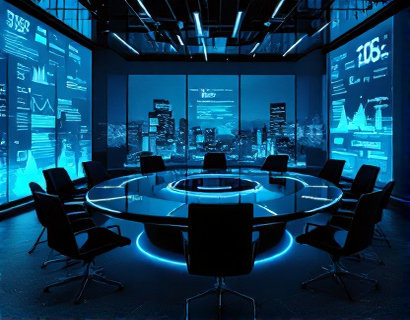Custom Business Card Creation for E-commerce Brands: A Guide to Professional Branding and Online Success
In the digital age, where online presence is paramount, the physical business card remains a crucial element of professional branding. For e-commerce brands, creating a distinctive business card is an opportunity to make a lasting impression and reinforce brand identity. This guide provides an in-depth look at how to design and produce custom business cards that not only stand out but also align with your brand's unique identity and values.
For freelancers, entrepreneurs, and corporate leaders, the business card is more than just a piece of paper. It is an extension of your brand, a tangible representation of your professionalism and attention to detail. A well-designed business card can open doors, foster connections, and leave a memorable impression. In this article, we will explore the key elements of custom business card creation, from selecting the right design to ensuring high-quality production and distribution.
Understanding the Importance of Custom Business Cards
The first impression matters, and in the world of e-commerce, where customers interact with your brand primarily through digital channels, the physical business card serves as a bridge between the online and offline worlds. A custom business card can differentiate you from competitors, showcase your brand's personality, and reinforce your brand message.
For e-commerce brands, the business card is often the first physical touchpoint a customer has with your brand. It can be exchanged at trade shows, conferences, networking events, or even as a follow-up after an online interaction. A well-designed card can enhance your brand's credibility and professionalism, making it a valuable tool in your marketing strategy.
Key Elements of a Effective Business Card Design
To create a business card that truly represents your brand, consider the following key elements:
- Logo and Brand Colors: Use your brand's logo and color scheme consistently. This helps in building brand recognition and reinforces your brand identity.
- Typography: Choose fonts that align with your brand's tone and are easy to read. Limit the number of font styles to maintain a clean and professional look.
- Imagery: Incorporate high-quality images or graphics that reflect your brand's personality and values. This could be a custom illustration, a product image, or an abstract design.
- Contact Information: Ensure that all necessary contact details are clearly visible and easy to read. Include your name, title, phone number, email, and website URL.
- Unique Selling Proposition (USP): Consider adding a brief tagline or statement that highlights what sets your brand apart from competitors.
By thoughtfully incorporating these elements, you can create a business card that not only looks professional but also effectively communicates your brand's message.
Selecting the Right Design Template
With the vast array of design options available, choosing the right template can be overwhelming. Here are some tips to help you select a template that aligns with your brand:
First, consider the industry and target audience. For instance, a tech startup might opt for a modern, minimalist design with a focus on clean lines and simple typography, while a creative agency might choose a more vibrant and artistic template.
Next, look for templates that offer customization options. A good template should provide a solid foundation while allowing you to add your unique touches. This could include customizing the background color, adjusting the layout, or adding a unique graphic.
Online platforms often provide a wide range of templates categorized by industry, style, and purpose. Browse through these categories to find inspiration and narrow down your options. Pay attention to the overall aesthetic and how well the template represents your brand's values and personality.
Once you have selected a template, use design tools to make adjustments. Most platforms offer drag-and-drop functionality, allowing you to easily modify elements such as text, images, and colors. Take the time to experiment with different combinations to find the perfect balance for your brand.
Customization Options for a Personal Touch
Customization is key to creating a business card that truly stands out. Here are some advanced customization options to consider:
First, explore different paper types and finishes. Matte, glossy, and textured papers can significantly impact the feel and appearance of your card. For example, a matte finish can give a sleek and professional look, while a textured paper can add a tactile element that makes your card more memorable.
Second, consider adding special features such as embossing, foil stamping, or spot UV coating. These techniques can add a premium touch and make your card more tactile and visually appealing. Embossing raises the text or design, creating a three-dimensional effect, while foil stamping adds a metallic finish to specific areas.
Third, think about the card's shape and size. Standard business cards are 3.5 x 2 inches, but you can opt for unique dimensions or shapes to make your card more distinctive. For example, a square card or a card with rounded corners can set you apart from the crowd.
Lastly, consider including interactive elements such as QR codes. A QR code can link to your website, a specific product page, or a video presentation, providing a seamless way for recipients to learn more about your brand.
Ensuring High-Quality Production
Once your design is finalized, the next step is to ensure high-quality production. Here are some factors to consider:
First, choose a reputable printing service that specializes in business cards. Look for reviews and testimonials to gauge the quality and reliability of the service. A reputable printer will use high-quality materials and advanced printing techniques to ensure your cards meet your standards.
Second, pay attention to the printing process. Offset printing is known for its high-quality results, especially for larger orders. Digital printing is more cost-effective for smaller runs and allows for quick turnaround times. Consider your order quantity and budget when selecting a printing method.
Third, proof your design before finalizing the order. Most printing services offer digital proofs that allow you to review the final product. Check the colors, text, and layout to ensure everything is accurate. This step can save you from costly mistakes and ensure your cards meet your expectations.
Finally, consider the packaging and delivery options. Opt for secure packaging to prevent damage during transit. Fast and reliable shipping is also crucial, especially if you need your cards for an upcoming event or deadline.
Strategic Distribution for Maximum Impact
Distributing your business cards effectively is just as important as designing them. Here are some strategies to maximize their impact:
First, tailor your distribution to your target audience. If you're attending a industry-specific conference, ensure you have enough cards for all the attendees you plan to meet. Personalize each card if possible, addressing the recipient by name to add a personal touch.
Second, combine your business card distribution with other marketing efforts. For example, follow up with a personalized email or social media message to reinforce the connection made through the card. This multi-channel approach can help build stronger relationships and increase the likelihood of converting leads into customers.
Third, consider using business card holders or dispensers at events. These tools not only keep your cards organized but also make them more accessible and visible. A well-designed holder can complement your cards and further enhance your brand's professional image.
Lastly, track the effectiveness of your business card distribution. Keep a log of events where you distributed cards and follow up with new contacts. This data can help you refine your networking strategy and identify which approaches yield the best results.
Conclusion
Creating a custom business card is a vital step in building a strong professional brand for e-commerce brands. By focusing on key design elements, selecting the right template, adding unique customization options, ensuring high-quality production, and strategically distributing your cards, you can make a lasting impression and enhance your online and offline presence.
Remember, your business card is an extension of your brand, and investing time and effort into its design and production can pay off in terms of networking success and brand recognition. Whether you're a freelancer, entrepreneur, or corporate leader, a well-designed business card is an essential tool in your marketing toolkit.











































